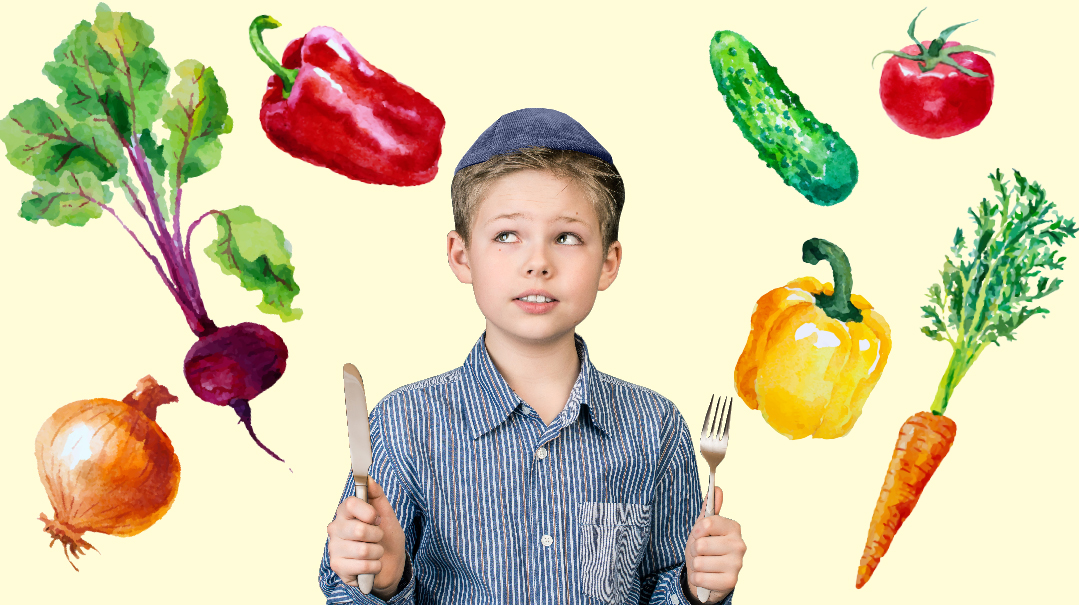The Great Veggie Experiment
| June 29, 2021One desperate mom’s quest to get her kids to eat more veggies

Of all the things I feel mommy guilt about, my children’s vegetable intake is pretty low on the list. I’ve tried over the years, cycling through many phases including: This Looks Like a Promising Strategy; Maybe They Won’t Notice This in the Food; and most frequently, That Was a Lot of Work for Little Reward.
Twelve years into parenting, the feeling I most associate with my kids and vegetables is hopelessness. Now I choose to focus on our strengths. We’re great at fruits. Unparalleled at carb consumption.
The first time I realized that not every child’s eating habits are created equal was one Shabbos when my oldest was a toddler. We were spending the long afternoon at a friend’s house. As we sat around the table, I looked on in astonishment as my friend’s toddler, around the same age as my oldest, ate a full plate of salmon, vegetables, and rice that wasn’t just plain white —essentially a whole adult meal.
My child was eating Cheerios. I made some comment on the difference between our children’s food preferences, and my friend’s husband told me that if I’d just put a variety of food in front of my child, my child would eat it.
Even now, I can still feel the sinking sensation I experienced when I heard that if I’d only make more of an effort, things would be different. In front of my child, that meal would’ve remained untouched. Hence the Cheerios diet and my decision to relegate vegetable intake to the “battles that aren’t worth fighting” category.
Recently though, a healthcare professional went into excruciating detail about how crucial it is for my children, aged two through twelve, to get the appropriate amount of nutrients from vegetables because of their huge impact on brain development. My dormant mommy guilt rocketed right up to the “I’m completely failing my children” level.
So when Family First asked if I’d be interested in trying to get my children to eat more vegetables and then write up the results, I was all for it. Taking on something like this as a fun project is much less terrifying than doing it because of the pressure of parental responsibility!
Information Gathering
To start, I put the question of how to increase my children’s vegetable intake out there on social media. Answers came pouring in. People apparently love to talk about their strategies and their successes — or lack thereof.
There were some suggestions that I liked but weren’t relevant for this article, such as growing our own vegetables (not enough time to do that), start the good eating habits when they’re babies (that ship has sailed), or to simply keep junk out of the house (I don’t want a full-scale revolt, thank you very much).
And then there were some validating responses from what I consider my kind of people: “Tried everything. I’ve officially surrendered,” and “Does M&M yogurt count as a health food?”
Still, there was a sizable number of responses that were just right. They fell into the following categories:
1.Trickery — hiding the vegetables in sauces or baked goods
2.Exposure — having vegetables frequently available
3.Modeling — eating vegetables myself, in front of my kids
4.Involvement — having the kids help prepare the dinner or plan the menu
These were all strategies I’d tried (and abandoned) over the years, but approaching them from a new and hopefully less emotionally charged perspective was surprisingly appealing.
As for my emotions, something I hadn’t anticipated about this information-gathering stage was how deeply I’d been affected by reading about other people’s successes. Apparently, my mommy guilt on this issue is alive and well, just buried under layers of other things to worry about, like screen-time allowance.
Getting Advice
Someone connected me with Yaffi Lvova, a pediatric and family dietitian who is focused on encouraging children to develop a positive relationship with food. Still feeling raw from my perceived failure to correctly nurture my children, I opened her email warily.
In her email she said — get this! — that kids don’t need to eat vegetables at all. They’re able to get the nutrients they need from other sources, like fruit (we’re great at fruit!) and whole grains (well, we’re great at fruit).
She also said that if a parent makes a big deal about eating vegetables, it’s likely to backfire, and that kids need 15-40 exposures to a food before it will seem “familiar” and “safe.”
She explained that parents don’t need to “get” their kid to eat anything, but rather, to “put out the food and set the mood.” How refreshing!
Yaffi shared a number of helpful strategies — some had already been mentioned by all the helpful volunteers, and some I hadn’t considered — like playing food-based mindfulness games at the table, buying coloring and reading books about food, watching cooking shows together, and going to a farmer’s market or a U-pick farm.
Armed with renewed excitement and a list of all the vegetables I could remember ever serving, I sat with my children around the kitchen table to do a little investigation. I named one vegetable at a time, instructing my kids to raise their hand if they liked it.
It went how you might expect: cucumbers, tomatoes, and peppers got some votes. Most other vegetables remained in the “dislike” column. One child claimed to have never even heard of zucchini, cauliflower, celery, or eggplant. Another said, “I don’t like any vegetables!”
I clearly had my work cut out for me.
Setting Parameters
I wanted this to be as natural as possible, so I wasn’t going to tell my children I was experimenting on them. I would just present these uncharacteristically vegetable-full meals as nonchalantly as possible. I wasn’t going to encourage them to eat any more than I would any other meal (which isn’t much anyways; that encouragement is my husband’s department).
Each day I’d try a different strategy. Yes, this isn’t the most scientifically rigorous method, but I’m a musician/writer/mommy, not a researcher, so cut me some slack.
Breakfast is too hectic a time to change the routine, so I ruled that out, which left the after-school snack and dinner, as my kids get lunch at school.
I wanted to create a menu plan with vegetables that weren’t too time-intensive to prep (here in Cleveland we don’t have bug-free everything, and my level of patience for checking is very low). Then there was the question of what counts as a vegetable. I know that tomatoes are actually fruits, but the FDA website includes them on the vegetable list, so I was going to count them.
Here’s the plan:
Sunday — my most hectic day. It seemed more sensible to devote it to buying the vegetables I’d need for the week.
Monday — roasting and grilling
After-school snack: cauliflower popcorn, recommended by my friend Brocha.
Dinner: sliders with romaine lettuce, tomatoes, and red onions. For sides, roasted beets and grilled sweet potatoes.
Tuesday — smothered and covered
After-school snack: breaded zucchini circles with marinara sauce and yogurt sauce.
Dinner: salmon, (completely white) rice, cheesy broccoli.
Wednesday — play with your food
After-school snack: kabobs, using food as art.
Dinner: hot dogs and chicken, getting my kids to cut up veggies for a side.
Thursday — hiding and disguising
Breakfast: smoothies and carrot muffins (I don’t know why I thought I should include breakfast this one day).
Dinner: pizza with spinach and carrots blended into the sauce.
Friday — just as they are
After-school snack: raw veggies with dips.
I felt really good about my plan and was excited to see what would actually happen. At the same time, I tried to keep my expectations very low.
The Execution
Monday
Before my children came home, I made a batch of popcorn cauliflower, prepped the beets to go in the oven, and wrapped the sweet potatoes in foil to go on the grill. I also sliced the tomatoes, red onions, and put some (pre-checked) Romaine lettuce in a bowl for toppings. Is anyone quite so hopeful as a mother who thinks this just might be the day her children eat more vegetables?
I strategically placed the cauliflower popcorn on the kitchen table for my children to notice as they arrived. They ignored it and headed to the swimming pool instead.
My husband made up for their lack of interest. “This is really good,” he said, popping another handful in his mouth. Well, I guess this counts as being good role models! I relocated the bowl to our porch table where I would serve dinner.
I’d love to say that we were all sitting at the table together at six o’clock, but by the time dinner was actually ready, two kids were still in the pool, and one was biking around the neighborhood with a friend. It was just my husband, me, and my oldest and youngest. I felt a tug of concern that maybe this plan was wildly unrealistic.
After the rest of the family eventually came to the table, three of my kids tried the popcorn cauliflower, probably because they heard the word “popcorn.” It was hardly a runaway success (Sorry, Brocha. Raphael and I loved it, though).
On a more positive note, one child had tomato and lettuce with her slider, one just had lettuce, and one of my pickier eaters actually tried the lettuce.
“It’s not thumbs up or thumbs down for me,” he reported. “But it’s still not my taste.” I’ll take that as a win!
None of the kids touched the roasted beets (fine, more for me) and the sweet potatoes came off the grill way too late for anyone to even try them. Oh, well.
Tuesday
Buoyed by yesterday’s semi-success, I was excited to prepare today’s afterschool snack: zucchini rounds coated with panko bread crumbs and parmesan, then baked. I did have to set aside a good chunk of time to do the breading, and I didn’t time it quite right, so it wasn’t ready immediately when my kindergartener came off the bus.
He went straight to the pool. I totally neglected to factor this in when I was planning the after-school snacks. No one’s going to pay attention to any snack as long as there’s sunshine (not that I’m complaining).
I put the zucchini rounds on the back porch table, along with a bowl of warmed-up marinara sauce (yes, I was going all-out full-service for this experiment) and a bowl of delicious Greek yogurt/parsley dip which I was 100% sure my children wouldn’t touch but that I’d thoroughly enjoy.
My husband, again, was dedicated to being a good role model. “These are amazing!” he said happily.
My third grader wandered by and said, “Mmmm, that looks good!” but then was off to swim and never actually sampled any.
Once my kindergartener actually came out of the water, came over, and looked at the snack. “What are these?” he asked curiously. Then he immediately became suspicious. “Wait, why is it green?”
“Just take a no-thank-you bite,” I suggested as nonchalantly as possible, considering the amount of time and effort I’d put into this particular snack.
“Okay,” he said with a shrug. He took a microscopic bite and swiftly spit it out onto the porch. “It’s not my taste, Mommy.” Yeah, no kidding.
I had high hopes for the cheesy broccoli at dinner. After I brought it out, though, one of my kids took a really cheesy floret but no more, another kid stated that he liked neither cheese nor broccoli, another kid liked the broccoli but not the cheese, and my pickiest eater declined to try it at all. He had the rice. Just the rice.
My husband held out a floret to my toddler, asking her if she wanted a “broccoli pop,” and she spent the rest of the meal saying “yummy pop!” So, not a total flop, but not the results I’d been hoping for. I reminded myself that I needed to lower my expectations — and then lower them some more.
Even though it was only the second day of the experiment, I realized my husband and I were eating significantly more vegetables than usual (okay, yes, it’s easy to see the increase when our intake had been essentially zero), and it wasn’t as difficult to integrate these vegetables into our lives as I’d thought. If I was able to keep it up, my toddler would be more exposed to vegetables than the child right above her, and I liked the way that felt.
Wednesday
I didn’t really have a concrete plan for this day, and I also forgot that Wednesdays are super hectic because my six-year-old has swimming lessons after school, so I usually just prepare the simplest dinner and run out the door.
After a deflating experience Googling “food play ideas” (how do people have so much time to dedicate to these elaborate activities?) I ended up cutting cucumbers, bell peppers, carrots, and grape tomatoes into various shapes, stacking them on top of each other, and securing the stacks with a toothpick. Not quite the impressive presentation I’d imagined, but it was kind of cute.
My nine-year-old came home with a bagful of glazed donuts, leftover from her birthday celebration at school. Oh, right. Another thing I forgot to factor in. Great.
But then something miraculous happened. She set the donuts on the table, took one of the veggie stacks, and ate it! And then ate another one!
When my fourth-grader came home, he settled in at the kitchen table with a book and steadily noshed on the veggie stacks too! I felt like I needed to apologize for rolling my eyes at all the people who told me that if I just put vegetables in front of my children, they’ll eat them if they’re hungry. But these two are my most adventurous eaters. The other kids were still completely uninterested in trying any vegetables.
It was nearly time to run to swimming lessons, and I hadn’t even tried my other plan for the day.
“Anyone want to cut up some vegetables for dinner?” I asked half-heartedly.
“No, thanks, I’m good.”
“Not today, Mommy.”
Well, considering the lack of effort I put into this day, and the things I forgot to factor in, it went surprisingly well.
Thursday
When I looked at my menu plan, I realized I was clearly way too ambitious. Smoothies and carrot muffins for breakfast? When exactly was I planning on accomplishing that?
In the golden part of the day when I’m awake and my children are asleep, I did a quick search online for smoothie recipes. I found a recipe for a banana, strawberry, and spinach smoothie (only four ingredients it proclaimed) and was excited as I filled the blender. Then I got nervous that there wasn’t going to be enough, so I impulsively doubled the recipe. Please tell me I’m not the only one who does this. As I watched the ingredients whir around, I noticed in dismay that the color was decidedly green. Hmmm.
“Who wants a smoothie?” I cheerfully asked my sleepy children sitting around the kitchen table.
“What’s in it?” asked my sensible ten-year-old.
“Banana, strawberry, water, and spinach.” I wanted to whisper the last ingredient.
“I guess I’ll try some,” said my most easygoing child skeptically.
My third grader was the most enthused about it, drinking about a half a cup. My ten-year-old, the pleasant but dubious child, informed me, “Sorry, Mommy, it’s too much spinach for me.”
The others steered clear of this experiment altogether. That left about ten and a half cups of smoothie for me to finish while they were in school. Again, I’m practicing very good modeling through this project!
Instead of the carrot muffins for breakfast, I opted to make a carrot cake for the after- school snack. I wasn’t sure if the carrots in the cake would make this snack less appealing. I’ll spare you the suspense; it did, but only for the children who were already averse to eating carrots. No shocker there.
We have pizza every Thursday. Sometimes I make the dough, sometimes I buy premade dough, sometimes we order out, but the pizza is a constant. For years I’ve heard people recommend putting vegetables in sauce, but I’ve always completely discounted this advice because my children don’t eat sauce. Not on any shape of noodles, not with meatballs (they don’t actually eat meatballs, either), not at all. But during the information-gathering phase of this project, a friend sent me a voice note where she suggested I hide the vegetables in pizza sauce. Pizza sauce! This might actually work!
I wanted to include vegetables that had nutrients but would hopefully be undetectable. I chose carrots, and, perhaps unwisely, spinach. I was counting on the cheese to hide any suspicious colors. I made two pizzas, one with the doctored-up sauce and one “safe” pizza just in case they could tell. I was so nervous. Messing with pizza night was risky.
But they didn’t notice. They didn’t notice. Even my most picky eater ate with gusto. Toward the end of the evening, my nine-year-old wanted a little more to eat. All that was left was one slice of the “special” pizza and one slice of the “normal” pizza. I put them together on a plate and placed it in front of her.
“Um, Mommy?” she said apprehensively. “This piece looks a little moldy.” She pointed to the special piece.
Busted. “Oh, I used a different sauce for that one,” I replied coolly. “I promise you, it’s not moldy.” She ate it, albeit with some reluctance. Mental note: no backup pizza next time.
Friday
I sliced a cucumber, a red, orange, and yellow bell pepper, some baby carrots, and some grape tomatoes and placed them in some pretty (unbreakable) bowls on the kitchen table. While I felt this was a little risky, what with my toddler and all, I also figured it wasn’t the worst thing in the world if my toddler snacked more than my other kids.
To jazz things up a bit, I purchased three different kinds of dips: ranch, honey mustard, and Thousand Island. Those went on the table as well in cute little bowls, and I went on to complete the whirlwind of my Shabbos cooking.
Like the other days, my children who are not super-averse to vegetables ate a decent amount, and I felt really good about that. I realized that all these years, the narrative I have about how my children “don’t eat vegetables” is really only applicable to two out of five of my kids. Why was I letting my pickiest eaters determine the way I approached feeding my family?
The whole week, it felt so easy to provide all these vegetable options for my kids. I know that without the level of focus that comes with a project like this, it will be all too easy to slip back into our old routine. But for the first time, I actually feel a glimmer of hope.
(Originally featured in Family First, Issue 749)
Oops! We could not locate your form.












